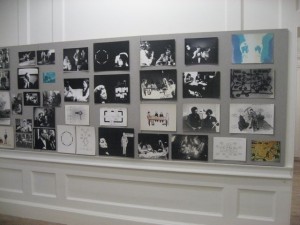Monday January 14th The Truth hurts
Today I returned to Tate Britain for my last intensive stint at Tate Archive. I had pre-ordered items to study so got straight in there. The Tate was amazingly quiet today, almost deserted, as, since my last visit, the Turner Prize and Pre-Raphaelite shows have finished, and there’s a gap until the Kurt Schwitters show starts on Jan 30th. Interesting getting a behind the scenes view of the elaborate process for packing and moving the paintings out-each work is packaged like a complex sculpture, and involves lots of staff.
Of great interest was a battered “Art Monthly” magazine from 1980, with an article by artist Ian Breakwell on 2 APG placements he undertook with the DHSS at Broadmoor Hospital, and in care homes for the elderly.
The report he produced was considered so radical it deeply offended Broadmoor management and embarrassed DHSS. (Bit like Stuart Brisley’s Report at Hille.) Official Secrets Act prevented wider airing of proposals contained within it. Artists get to the truth of the matter and the truth hurts. This kind of shows the APG ‘Incidental Person’ experiment working though.
TGA 20042/5/2/4. ‘Art Monthly” Number 40. 1980.
“…..We told the truth as we saw it, and made positive proposals for progressive change, and the day may yet come when account will have to be taken of our study, which remains the only one of its kind.”
Breakwell said on one level his placement was a success- he was successfully integrated into the DHSS, and they were prepared to incorporate his unorthodox approach. However, when this was taken to another level – where the DHSS Team were themselves placed within a host organisation – Broadmoor, the host organisation proved to be inflexible and conservative when presented with the findings, and was thus a ‘failure’.
….”The very terms “success” and “failure” may have to be rethought, for the success of a placement cannot be measured merely by the degree of mutual back-slapping between the host organisation and the artist. A timid artist will produce timid work, and this will be acceptable to timid host organisation. An artist with a radical attitude may well produce radical effects, and this may or may not be acceptable to the host organisation, or if it is then the effects may not be acceptable to the host organisation’s clients. A third party might perceive, however, that the latter was the more meaningful (‘successful’) placement because it brought bigger issues to the surface, even if in the process it caused trouble and turmoil.In a placement the ‘artwork’ is not the end product but the whole process..”
Following the Broadmoor placement, Breakwell attempted to extend the experiences of his placement into his personal artworks, (as far as the restrictions of the Official Secrets Act would allow), and presenting them publicly.
This seems a different way of using the placements creatively-as an impetus or inspiration for new work – and as a tool to promote social and political change. I respond to the idea of trying to present this ‘closed’ world to the public through art .
In 1977, he published book “Diary Extracts 1968-1976” which included sections written whilst on placement with the DHSS.In 1978 a tape cassette version was published by Audio Arts, London. (Ian Breakwell.`”Continuous Diary’ publ. 1978, Audio Arts, 6, Briarwood RD, London SW4.)

